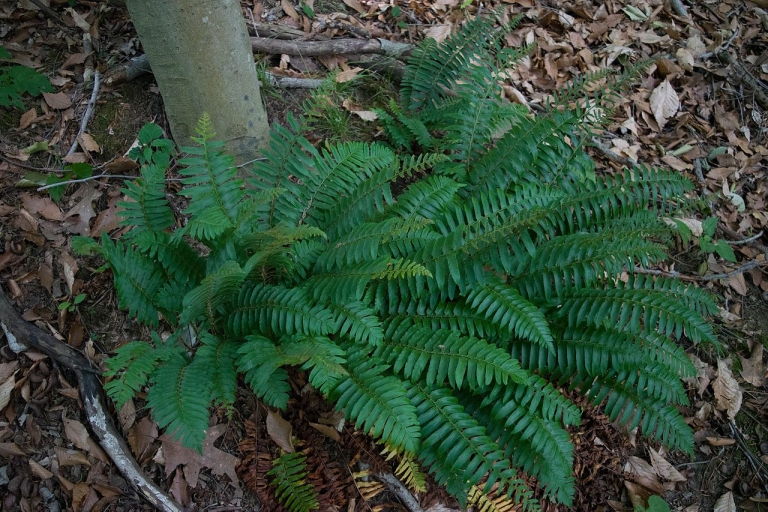In my humble opinion, ferns are one of the most overlooked groups of plants in West Virginia forests and woodlands. Here in Greenbrier County, more than 50 different species thrive. I can’t claim to be an expert in fern identification, and that’s not because they’re complicated, it’s just that I haven’t had the time to really study them to the depths that I’d like to. Perhaps, when I grow up, I’ll have more time.
Certainly, the most ubiquitous fern we encounter on our woodland walks and hikes is Polystichum acrostichoides, or The “Christmas Fern.” Why do folks call this evergreen fern the “Christmas Fern”? There are two reasons, and they both involve the individual pinnae, or leaf blades, on the frond. If you hold them horizontally, they resemble Santa Claus standing up on the back of his sled. If you hold them vertically, they resemble a Christmas stocking. C’mon, kids! A little imagination goes a long way here.
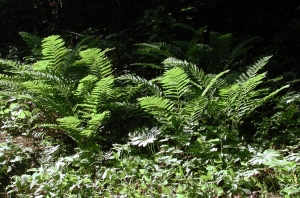
My favorite genus in Fernworld is Osmunda. This genus is named for Osmunder, the Saxon equivalent of the god Thor. There are three species of Osmunda in the genus.
Osmunda claytoniana, or the “Interrupted Fern,” is quite fascinating. The sterile fronds (those that are not spore-bearing) grow for a while and then pause to produce spore-bearing fertile pinnae then resume growing in the sterile mode. Osmunda claytoniana is found in a wide variety of habitats throughout the state.
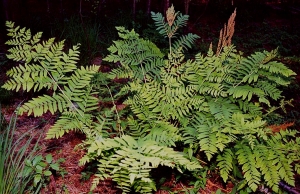
Osmunda regalis or the “Royal Fern” can be easily identified as it produces fertile spores at the tip of its fronds. Osmunda regalis is found in moist and swampy locations throughout the state. Osmunda regalis reproduces quite quickly via rhizome (underground stems) and by spore....but more on Fern Sex later.
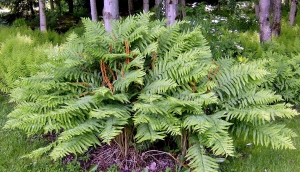
Osmunda cinnamomea, known as the “Cinnamon Fern,” produces its spores on separate leaf blades arising from the center of the plant. They’re a woolly cinnamon brown color and resemble cinnamon sticks.
Botrychium is known as “Grape Ferns” because of the attractive shape of their spore clusters which resemble bunches of grapes. They can be found in well-drained soil in the woods and partially shaded meadows. These ferns are more difficult to transplant than most other ferns due to their dependency on soil fungi that help feed them.
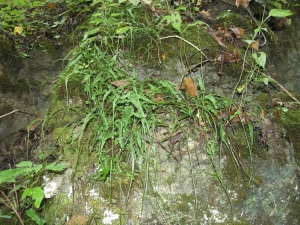
Another curiosity in the Fern World is Camptosorus rhizophyllus, AKA the “Walking Fern.” This distinctive little fellow has four-inch to 12-inch long leathery leaves tapered to a point. It reproduces not only by spores but also by forming new plantlets at the tips of its fronds that root themselves as the tip comes in contact with the soil. As each new plant becomes established, the process continues and, after a few years, the newest baby is quite a ways from its mamma.
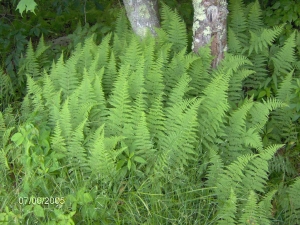
Dennstaedtia punctilobula is commonly called the “Hay Scented Fern,” and with good reason. If you crush the frond, it gives off a fragrance of newly mowed grass. It can be found in large colonies in the full sun of open meadows and in shady woods.
Lygodium palmatum, or the “Climbing Fern,” is another curiosity among ferns. It grows in acid woods in only five of the 55 counties in West Virginia. Its winding fronds can grow to more than three feet long.
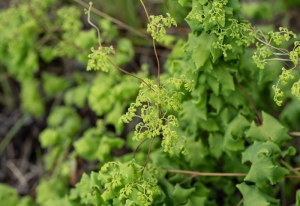
The reproductive life cycle of ferns is quite intriguing. Spores are found in various locations on the different species, usually on the undersides of the fronds. When the time is right, and these spores are mature, they’re released. They land in the soil and under favorable conditions (i.e. moisture, light, and temperature) develop into a prothallus, a leaf-like structure smaller than a dime. In this structure, microscopic sexual organs are formed, and fertilization occurs. Soon afterward, a root develops and, shortly thereafter, a recognizable plant.
This process can be reproduced in the kitchen, and you may just end up with thousands of new fern babies. Even if you don’t want to reproduce ferns, it’s fun to take a frond and lay it on a white sheet of paper in a warm location. In 24 hours, the sori (the scientific name for the capsules that enclose the spores) will open and release the spores onto the paper in a beautiful outline of the frond.
Some ferns also reproduce by sending out rhizomes (underground stems) that pop up a foot or so from the main plant with a new plant attached. The “Royal Fern” forms a nice little colony this way very quickly.
Ferns fill a void in the garden. They can add an attractive texture creating a dramatic statement as a single specimen or as a colony in the wild or natural shade garden. They require little attention other than an occasional feeding and cleanup of the previous growing season’s fronds, depending on how tidy you keep your garden.
Many other ferns and fern allies are too numerous to mention on this small soapbox. If this short intro into the magical world of ferns has piqued your interest, you can go to Amazon and choose from many Fern Field Identification guides.
Till our next horticultural excursion, Peace Out!
Barry Glick's mountaintop garden and nursery attract gardeners from every country in the world. He writes and lectures extensively about native plants and hellebores and welcomes visitors with advance notice. He can be reached at barry@sunfarm.com, Sunfarm.com, or 304-497-2208.

























